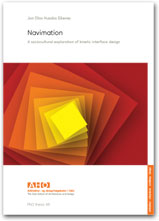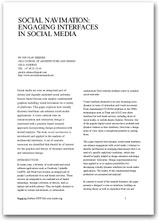General
3,5 års arbeid på 6 minutt og 40 sekund
(In Norwegian only. English version underway)
For nokre veker sidan oppsummerte eg doktorgradsprosjektet mitt på 6 minutt og 40 sekund. Her ser du resultatet:
Denne presentasjonen vart laga for Pecha Kucha Night Oslo, som arrangerast med jamne mellomrom på DogA. Pecha Kucha skal vere ein inspirasjonskveld med lynforedrag om arkitektur, design og kunst. Kvar talar får ta med 20 bilete som kvart blir vist i 20 sekund, til saman 6 minutt og 40 sekund. Heldigvis fekk eg lov å bytte ut nokre av bileta med video – noko som var essensielt for å formidle arbeidet mitt.
PhD thesis online
The public defence of my PhD thesis took place at AHO, December 22. The thesis, entitled Navimation: a sociocultural exploration of kinetic interface design is now available online, through AHO’s open access archive ADORA.
The thesis consists of a metareflection (kappe) and three publications. All publications have gone through peer-review and have been published before. The metareflection situates and extends these publications by providing more theoretical background and introducing new concepts and models.
Download the documents below:
Metareflection
 Eikenes, J.O.(2010). Navimation: a sociocultural exploration of kinetic interface design. Doctoral thesis, Oslo School of Architecture and Design, Institute of Design, Oslo. Eikenes, J.O.(2010). Navimation: a sociocultural exploration of kinetic interface design. Doctoral thesis, Oslo School of Architecture and Design, Institute of Design, Oslo.
|
Publication 1
 Eikenes, J.O. and A. Morrison (2010). Navimation: Exploring time, space & motion in the design of screen-based interfaces. International Journal of Design, 4(1), 1-16. Eikenes, J.O. and A. Morrison (2010). Navimation: Exploring time, space & motion in the design of screen-based interfaces. International Journal of Design, 4(1), 1-16.
Also available from The International Journal of Design.. |
Publication 2
 Eikenes, J. O. (2009). Social navimation: Engaging interfaces in social media. Paper presented at Engaging Artifacts. The 3rd Nordic design research conference (NORDES). 31 August-1 September. Eikenes, J. O. (2009). Social navimation: Engaging interfaces in social media. Paper presented at Engaging Artifacts. The 3rd Nordic design research conference (NORDES). 31 August-1 September.
Download Publication 2 (0,6 MB) Also available from NORDES. |
Publication 3
 Eikenes, J.O.(2010). Connecting motional form to interface actions in web browsing: Investigating through motion sketching. FORMakademisk, 3(1), 80-100. Eikenes, J.O.(2010). Connecting motional form to interface actions in web browsing: Investigating through motion sketching. FORMakademisk, 3(1), 80-100.
Download Publication 3 (1,4 MB) Also available from FORMakademisk. I have also created an online version with embedded videos. |
New video: Kinetic Interface Design
In order to make my research more accessible I have created a video that shows a number of kinetic interfaces. Kinetic interfaces are here understood as screen-based interfaces that are characterized by movement.
Kinetic Interface Design from JonO on Vimeo.
In addition to the interface examples, a number of descriptive and analytical terms are presented. These terms have been developed through analysis of kinetic interfaces in academic publications. The kinetic interfaces presented in the video are:
The Apple OSX login box
NAVIMATION
The Iconist #1 (iPad)
www.leoburnett.ca
Disney Movies (iPad)
SOCIAL NAVIMATION
www.taggraph.com
Flipboard (iPad)
MOTIONAL TRANSFORMATION
www.jonathanyuen.com
www.well-formed-data.net/experiments/elastic_lists
SPATIAL MANIPULATION
For All Seasons (iPhone)
www.tryggtrafikk.no/Sykkelhjelm2010
www.ecodazoo.com
TEMPORAL NAVIGATION
Cooliris (iPhone)
www.wrangler-europe.com/bluebell/ss10/#/collection
www.flashloaded.com/flashcomponents/3dwall
INDEXICAL COMPOSITING
www.sectionseven.com/index2.html
www.homeinvest.no
VIRTUAL KINETICS
www.thewhalehunt.org
www.thibaud.be
Music: ‘Rieth’ from Gesamtlaufzeit by Marko Fürstenberg. (Used with permission.)
Presentasjon: Skisser utanfor boksen
(Only in Norwegian)
Her er presentasjonen min frå RECORD-seminaret på AHO 10. september 2010. Her argumenterer eg mellom anna for at utforming av grensesnittet er svært viktig i sosiale medier, noko som sjeldan vert snakka høgt om. Vidare snakkar eg om fire ulike måtar å skisse bevegelse på: 1) ved å bruke video + papirprototyping, 2) stop motion, 3) digital animasjon og 4) kode. For meir informasjon, sjå artikkelen Connecting motional form to interface actions in web browsing.
Skisser utanfor boksen
Sidan det ikkje er video i presentasjonen ovanfor, legg eg ved alle videoskissene mine her. Dei er sorterte etter handling, og viser dermed ulike måtar å 1) lagre medieelement (bilete) til ei samling, 2) navigere mellom ulike medieelement, og 3) opne ei samling av medieelement. Skissene er laga ved bruk av video, stop motion og animasjon i After Effects.
1. Ulike måtar å lagre medieelement til ei samling:
2. Ulike måtar å navigere mellom medieelement:
3. Ulike måtar å opne ei samling av medieelement:
New journal article published
Some time ago my second journal article was published by the academic journal FORMakademisk. This is an open-access journal, so the article is free for everyone to download as a PDF. In addition, I have made the article available as a webpage in order to embed videos and a Prezi presentation. The article is entitled ‘Connecting motional form to interface actions in web browsing: investigating through motion sketching’, and is based on work done in collaboration with Opera Software. Here is the abstract:
It is now possible to include complex visual movement in screen interfaces, including those that enable web browsing on different media devices. This article investigates the potential for employing movement in web browsing – or more specifically, how motional form may be connected to interface actions. The investigation is carried out through design experimentation. Techniques of ‘motion sketching’ have been developed and utilized in a practice-based research project. The resulting motion sketches are analysed as realizations of complex mediation – by drawing on social semiotics and the concept of action from Leont’ev. The article argues that motional form is made meaningful through connotations and experiential metaphors, and suggests ten provisional principles for how motional form may be used in web browsing. This challenges notions of form and function in current interface design and how social semiotic theory may be produced.
Search
Recent posts
- SpotTrack: Award for Design Excellence
- VizBox Bergen og årets geogründer
- Fulbright report: six months at the School of Cinematic Arts in Los Angeles
- The VizBox Experiments
- TopoBox: exploring a tangible dataviz platform
- Norway in 3D part I: from DEM to 3D surface
- Using visualization for understanding survey data
- Story kicking big data
- Fulbright project: Dynamic Information Visualization
- Visiting Fulbright scholar at USC in Los Angeles
- (E)motional design paper at DANDE2012
- 3,5 års arbeid på 6 minutt og 40 sekund
- PhD thesis online
- New video: Kinetic Interface Design
- Presentasjon: Skisser utanfor boksen